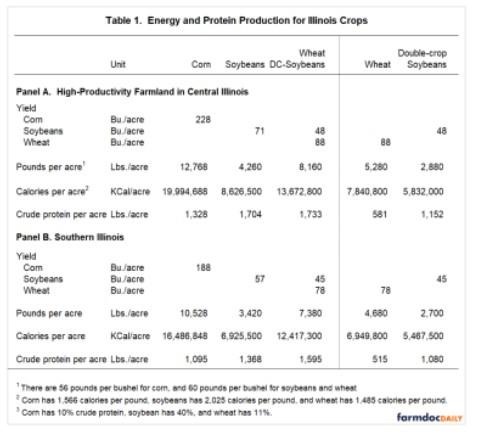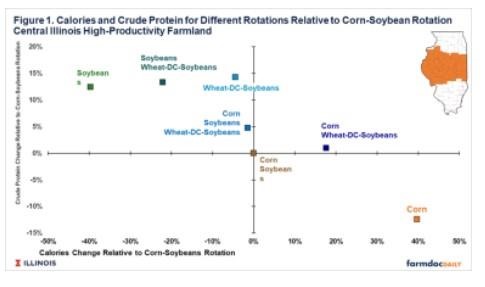By Gary Schnitkey and Jim Baltz et.al
Department of Agricultural and Consumer Economics
University of Illinois
Carl Zulauf
Department of Agricultural, Environmental and Development Economics
Ohio State University
For 2023, growing wheat followed by soybeans (wheat-double-crop-soybeans) currently is projected to be more profitable than growing either corn or soybeans, particularly in southern Illinois. Much of the higher projected profitability is due to higher prices caused by the Ukraine-Russia Conflict. However, in the longer run, yield increases in wheat-double-crop-soybeans need to occur before widespread practice adoption is warranted. We reach this conclusion by comparing calories and crude protein production across rotations. Calories and protein production are not that much greater for rotations containing wheat-double-crop-soybeans than for a standard corn-soybeans rotation, particularly on high-productivity farmland in central Illinois.
Recent Focus on Double-Crop Soybeans
Attention recently has focused on double-crop soybeans in a rotation with a winter crop. Over much of the U.S., double-crop soybeans are preceded by planting and harvest of a winter wheat crop. In this practice, wheat is planted in the fall and harvested in late June or early July. Immediately after the wheat harvest, soybeans are planted, with harvest of double-crop soybeans occurring after a killing frost in the fall.
Three reasons for this focus on double-crop-soybean rotations are:
- Ukraine-Russia war: The Ukraine-Russia war has caused grave concerns about agricultural exports from the Ukraine, with wheat being one of those exports. Even at today’s high wheat prices, wheat alone is not as profitable as corn or soybeans in single crop rotations. However, current projections indicate that wheat with double-crop soybeans is expected to be more profitable than stand-alone corn and soybeans in central and Southern Illinois (see farmdoc daily, March 29, 2022). Therefore, wheat-double-crop-soybeans is a way to increase wheat production, particularly in more southern areas east of the Mississippi. Similarly, Ukraine produces sunflowers, and sunflowers has the potential as a double-crop outside the Midwest.
- Wheat is a cover crop with a return: The wheat-double-crop-soybeans combination has been shown to reduce nitrate runoff in tile drainage studies. Because it begins growing in the fall and through the early spring, wheat is able to scavenge residual nitrogen in the fields during the months the field would otherwise be left fallow, the residual nutrients lost. As such, wheat has similar nitrate-reducing benefits as other cover crops that over-winter. In addition, there may be other environmental benefits to wheat in the rotation, such as increases in soil organic matter over time. Rather than terminating wheat in the spring, this rotation provides the farmer with a cash crop in addition to soybeans. In addition, there may be other environmental benefits to wheat in the rotation, such as increases in soil organic matter over time. Including wheat also may have the potential to reduce pest pressures in Midwest rotations.
- Strategic yield challenge: The U.S. has been losing its global share of grain production over time, with South American countries gaining share. Adding more double-crop practices may be one way to increase production (see farmdoc daily, May 2, 2022)
Comparison of Calories and Protein in Different Cropping Combinations
Planting corn, soybeans, and wheat-double-crop-soybeans will obviously result in different mixes of grains and oilseeds produced, all of which have specific uses. Our purpose here is to provide standardized comparisons across some common crop rotations. To make those comparisons, we use two measures:
- Calories per acre: Corn and wheat are designated as feed grains with the primary role of providing energy. An important use of that energy is in livestock diets. Calories per acre are a measure of the energy produced.
- Crude protein per acre: Soybeans are an oilseed. Soybeans were introduced in the United States to provide protein in the diets of livestock. Pounds of crude protein per acre is the selected measure.
Note that there are issues with both measures. For example, there are different types of proteins in the three crops, some more digestible than others, requiring more detailed comparisons when making production decisions, such as when balancing livestock rations. Still, the above two measures provide a useful gauge for comparing across crops.
Table 1 compares corn, soybeans, and wheat-double-crop-soybeans production on high-productivity farmland in central Illinois (Panel A) and southern Illinois (Panel B). For both regions, yields are at their 2022 expected levels, according to Illinois Crop Budgets.

The expected corn yield for high-productivity farmland in central Illinois is 228 bushels per acre or 12,768 pounds per acre (see Table 1). This corn contains 20.0 million calories, the highest of all three crops by a large margin. According to the May 2022 World Agricultural Supply and Demand Estimates (WASDE) report, 43% of corn use is for feed, while 34% is used in ethanol production. Both uses are related to energy use. Corn provides 1,328 pounds of crude protein per acre, the lowest of the three crop combinations.
Soybeans have an expected yield of 71 bushels per acre or 4,260 pounds per acre (see Table 1). Soybeans contains 8 million calories per acre, much lower than that from corn. According to the May 2022 WASDE report, 49% of U.S. soybean use is in “crush,” which produces soybean oil meal (SBOM) and oil as joint products. SBOM is predominately used as a protein source in livestock feed. Another 48% of U.S. soybeans are exported. In the exported country, most soybeans will be used in their domestic crush. Soybeans have 1,704 pounds of crude protein per acre.
Wheat in the wheat-double-crop-soybean practice has an expected yield of 88 bushels per acre or 5,280 pounds per acre (see Table 1). Calories from wheat are 7.8 million per acre, much less than that for corn. Crude portion is 581 pounds per acre, much less than protein from soybeans.
Food use is projected to be 51% of the use of wheat, while feed accounts for 4% of use (WASDE, May 2022). If wheat production exceeds food use, wheat could be used as livestock feed, at which point wheat would have to compete with corn as an energy source in livestock rations.
Double-crop soybeans have an expected yield of 48 bushels per acre or 2,880 pounds per acre (see Table 1). Calories are 5.8 million per acre. Crude protein is at 1,152 pounds per acre.
The wheat-double-crop-soybean practice has a total of 13.7 million calories. Total calories are less than corn (20.0 million/acre) but more than soybeans (8.7 million/acre). Crude protein production for the wheat-double-crop-soybean practices is 1,733 pounds per acre, slightly more than the 1,704 pounds per acre for soybeans.
Crop and Rotational Impacts on Total Energy and Protein Production
Raising different crops and rotations will result in different levels of energy and protein production. Figure 1 shows differences relative to a 50% corn and 50% soybeans rotation, a standard rotation in central Illinois. These are average values over all crops in the rotation. In Figure 1, the corn-soybean rotation is located at the zero point of both the calorie change and crude protein change axis. A stand-alone corn crop is in the lower-right quadrant, producing 40% more calories per acre but 12% less crude protein than the corn-soybeans rotation. At the other extreme is soybeans. Soybeans are in the upper-left quadrant, with 40% fewer calories per acre but 12% more crude protein per acre.

As a way to diversify their rotations, some farmers may add wheat-double-crop-soybeans to a corn-soybeans rotation, resulting in a three-year rotation. This rotation has 1% fewer calories produced than the corn-soybean rotation but 5% more crude protein per acre.
One rotation produces more calories and more crude protein than a corn-soybeans rotation, a two-year rotation consisting of one year of corn followed by wheat-double-crop-soybeans. This rotation has 8% more calories than the corn-soybean rotation, mainly because the low-calorie crop of soybeans is replaced with wheat-double-crop-soybeans. Crude portion is 1% higher than the corn-soybean rotation. Sixty-two percent of crude protein in this rotation comes from corn and wheat, while 38% comes from soybeans. Less of this rotation’s crude protein comes from soybeans, which will influence the amount of SBOM produced.
Figure 2 shows comparisons for southern Illinois. Only one cropping pattern produced both more calories and more crude protein in central Illinois as compared to three in southern Illinois: 1) Corn followed by wheat-double-crop-soybeans, 2) Corn, followed by soybeans, followed by wheat-double-crop-soybeans, and 3) wheat-double-crop-soybeans. Much of this has to do with the relative yields of the crops. Relative to soybeans, corn has a lower yield in southern Illinois than in central Illinois. As a result, corn calories are relatively lower in southern Illinois than in central Illinois.

Implications
Since the beginning of the Ukraine-Russia war, prices for corn, soybeans, and wheat have increased, but the price of wheat has increased relatively more. Wheat-double-crop-soybeans are currently projected to be more profitable than corn and soybeans. Farmers will consider these expectations as they make planting decisions for 2023. Expected prices can change between now and fall when wheat would be planted, changing relative profits between the cropping options.
In the longer run as prices move back to more normal relationships, yields from wheat-double-crop-soybeans need to increase before widespread adoption occurs, particularly in high-yielding areas such as central Illinois. Gains, measured by total calories and crude protein produced, from including wheat-double-crop soybeans are not that great, suggesting a switch to the more intensive practice is not likely without some other incentive. Moreover, a switch to more wheat would decrease wheat prices. A higher price for wheat is possible for food uses. Once food demand is met, wheat will have to compete with corn for space in livestock rations. Wheat likely will have difficulty competing with corn due to its lower calories per acre relative to corn.
Some technological breakthroughs could include a combination of:
- Wheat varieties that could be harvested earlier. Earlier harvest of wheat allowing for earlier planting of soybeans likely would increase soybean yields. Soybean yield risks would decrease because 1) soybeans would be planted in June when slightly lower temperatures prevail, and 2) a longer growing season increases the potential for higher yields.
- Wheat varieties that yield more.
- Double-crop soybean varieties that yield more. However, technology resulting in increased double-crop soybean yields would also likely increase soybean yields, limiting the relative competitiveness of double-crop soybeans.
Source : illinois.edu